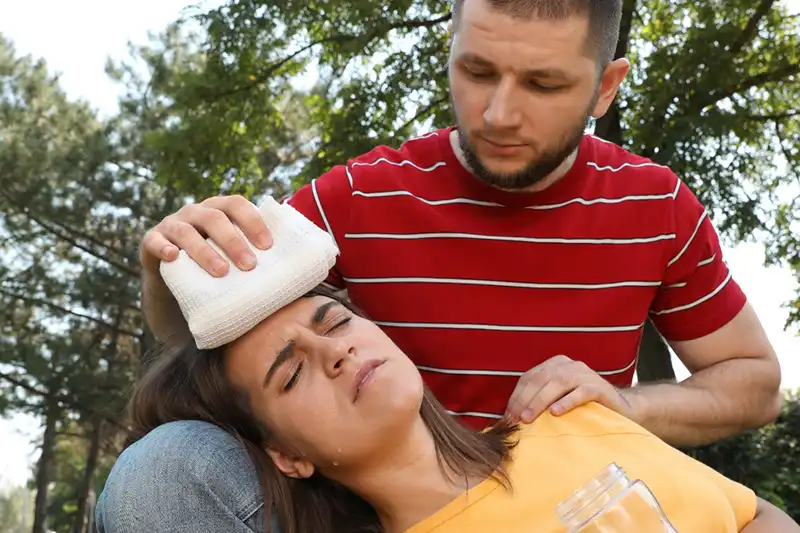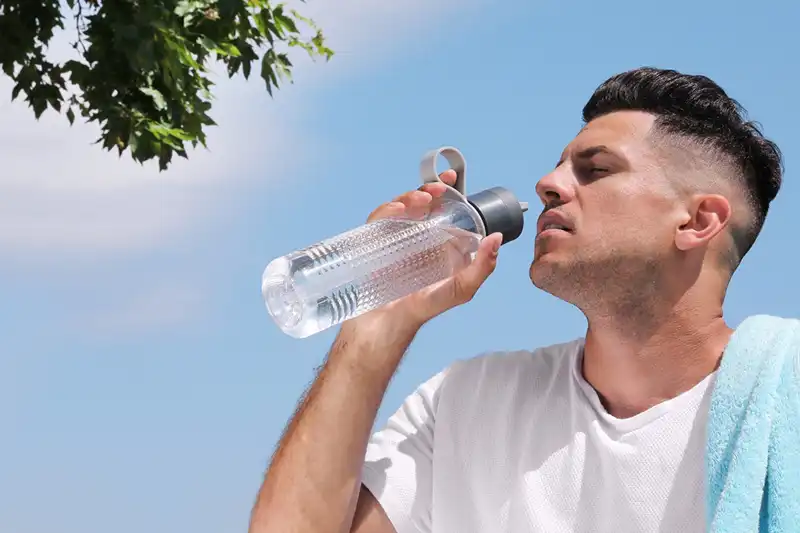Emergency Room for Heat Stroke Care
Summer arrives early in Texas, bringing with it scorching temperatures, intense humidity, and abundant sunshine. Every summer, residents of the Lone Star State face the risk of heat strokes and heat exhaustion. It’s important to be aware of the risks of heat strokes and heat exhaustion to protect yourself and your loved ones from its adverse effects. If you or someone you know is showing signs of heat stroke, seek immediate assistance at a Surepoint ER near you. Our dedicated team is available 24/7 to provide dependable relief when heat strokes become a threat!

What Is A Heat Stroke?
Heat strokes are a serious condition where the body temperature rises dangerously high, going beyond 104 degrees Fahrenheit. It’s also known as sunstroke and is the most severe form of heat-related illness, with potential risks like brain damage, organ failure, and, in extreme cases, death. This condition often develops from milder heat-related problems like cramps, fainting, or exhaustion. However, heat stroke can happen suddenly, even without warning signs. The main cause is prolonged exposure to high temperatures, along with dehydration, which impacts the body’s temperature control system. There are 2 main types of heat stroke: exertional and non-exertional.
- Exertional heat stroke: comes from overdoing physical activity in hot, humid conditions, usually happening within a few hours.
- Non-exertional heat stroke: or classic heat stroke, can develop slowly over several days due to factors like age or existing health issues.
Managing heat stroke involves recognizing the type, taking preventive measures, and getting medical help fast. If you think you might be experiencing a heat stroke, visit the Surepoint ER nearest you for fast medical care.
Surepoint is Open 24/7 Near You!
If you are experiencing nausea, seizures, confusion, disorientation, or any other serious heat stroke symptoms, please visit a Surepoint ER near you. We are open 24-7, no appointment needed.
What Causes Heat Strokes?
Heat strokes are a serious condition that can occur when you don’t drink enough fluids while exerting yourself in hot weather. You can develop heat stroke gradually over days or weeks by not replacing lost fluids, or you can bring it on quickly by engaging in strenuous activity on a hot day without proper hydration. The body uses liquids to cool itself through sweating, but it also needs them for important bodily functions like maintaining blood pressure. If you lose too much fluid through sweating, your body will start to conserve the remaining liquid for vital functions, stopping sweating altogether. This causes your body temperature to rise sharply, leading to cell damage and potentially life-threatening consequences. Dry weather can make you feel cooler because sweat evaporates more quickly, cooling the body more efficiently. However, in humid weather, the body’s temperature can rise faster, making it harder to cool down. That’s why weather forecasts include a humidity factor or heat index, which takes into account both the air temperature and humidity levels to give you a better idea of how hot it will actually feel outside. A heat index of 90°F or higher requires extreme caution. Certain individuals are more susceptible to heat stroke, including those with alcohol use disorders, chronic illnesses like heart disease, obesity, and older adults. These groups should take special precautions when working or exercising in hot weather. It’s important to note that heat stroke can occur even without obvious signs of dehydration, so it’s crucial to drink plenty of fluids and monitor your body temperature regularly.
What Are the Signs and Symptoms of Heat Strokes?

Experiencing a heat stroke is more than just feeling hot or sweating a lot. It’s a serious condition that can harm the brain, heart, kidneys, and muscles. Heat strokes can happen quickly, sometimes without any warning signs. Because heat strokes can cause confusion, it’s important to be aware of the signs and symptoms. Delaying treatment can lead to serious complications, so it’s important to act quickly. Common signs and symptoms of heat strokes include:
- Core body temperature above 104°F.
- Difficulty with movement and coordination
- Balance problems
- Confusion or disorientation
- Fainting or loss of consciousness
- Dizziness
- Excessive sweating
- Hot, flushed skin or very pale skin
- Low or high blood pressure
- Bubbling or gurgling sounds in the lungs
- Nausea and vomiting
- Low urine output
- Fast heart rate
- Seizures
Should I Go To The ER If I Think I’m Experiencing A Heat Stroke?
Yes, if you think you are experiencing a heat stroke, you should visit a Surepoint ER near you. Treatment for heat stroke needs to be done by a medical professional because it usually involves getting an IV of cool fluids and other steps to help your body get its internal temperature back under control. If you’re feeling tired, having headaches, stomach pains, chest discomfort, or struggling to concentrate, you might be unsure if it’s a heat stroke complication or a new health issue. That’s where Surepoint ER comes in. We’ll assess your symptoms, provide treatment, and help you get back on your feet. When deciding whether to visit the emergency room for a heat stroke, consider these factors:
- How severe are the symptoms? If you’re experiencing confusion, fainting, seizures, or a core body temperature above 104°F, it’s better to get medical help right away.
- How long have the symptoms been there? If they’re not getting better or are getting worse, it’s important to seek medical attention.
- Do you have any existing health issues? If you already have heart problems, respiratory issues, or trouble with heat regulation, you might be at a higher risk. In such cases, it’s a good idea to get checked out.
- Consider your age. If you’re very young, older, or have certain health conditions, you might be more vulnerable to heat-related problems.
- Have you tried cooling down? If basic cooling measures like moving to a cooler place and hydrating haven’t helped, it’s a sign you might need professional medical care.
If you’re feeling weak, fatigued, dizzy, or have other severe heat stroke symptoms, don’t hesitate, head to the ER immediately. Visit the closest Surepoint ER near you for immediate care!
Treating Heat Strokes at Surepoint ER
Heat stroke is a serious emergency that can be life-threatening or cause lasting harm to the brain and vital organs if you don’t get help quickly. The time you spend in the hospital depends on how severe the heat stroke is and how well your organs are working. Common treatments for heat stroke include:
- Fluid replacement: Doctors use IV fluids to replace the fluids and electrolytes lost. This helps bring back the body’s cooling mechanisms and prevents further dehydration.
- Cooling methods: They might use ice baths or apply cold compresses to areas like the neck, armpits, and groin to quickly lower the body’s temperature.
- Fans and misting: Fanning the patient and misting them with water can also help bring down the body’s temperature.
- Medications: Sometimes, medications like anticholinergics are used to help lower the body’s temperature.
Our Tips For Preventing Heat Strokes at Surepoint ER

While it may not always be possible to avoid the heat during the summer months, there are simple steps you can take to prepare for and prevent heat stroke. Here are some common tips to prevent heat strokes:
- Stay hydrated: Drink at least two full glasses of water each hour if you’re spending time outside or in hot conditions. This helps prevent heat exhaustion and heat stroke.
- Avoid peak sun hours: Try to avoid outdoor activities between 3:00 – 5:00 pm in Texas, which is the hottest part of the day. If you must be outside, take regular breaks in shaded areas and drink plenty of water.
- Dress appropriately: Wear lightweight, loose-fitting clothes to help keep you cool in hot weather.
Never leave someone in a parked car: Not even for a short time, as this can quickly lead to heat stroke. Make sure to bring children and pets inside with you if you need to run errands. - Be mindful of medications: Certain meds can cause dehydration, so talk to your doctor or pharmacist about potential side effects and take extra precautions to stay hydrated.
- Take it easy: If you’re at higher risk for heat stroke, try to limit your exposure to extreme temperatures and take frequent breaks in cooler environments.
- Limit alcohol intake: Drinking too much alcohol can lead to dehydration, hangovers, and an increased risk of heat-related illnesses since it affects your body’s ability to regulate its temperature.
- Protect your skin: Apply sunscreen regularly to avoid getting sunburned, which can make it harder for your body to cool itself down.
Don’t Miss the Signs: Recognize Severe Heat Stroke Emergencies and Act Fast!
As temperatures go up, so does the risk of heat stroke. If you’re worried about heat stroke symptoms like confusion or disorientation, hot, flushed skin, or very pale skin, we’re here to help. Surepoint Emergency Centers are open 24/7, no appointment necessary. Find a Surepoint ER near you by clicking the link below and get the care you need today!





